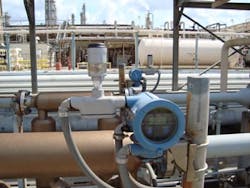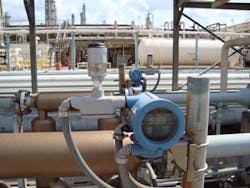Lara Kauchak, director of wireless sales and marketing for Emerson Process Management, fields questions from Flow Control editor-in-chief, Matt Migliore, on trends and applications of industrial wireless for fluid handling systems.
Q: While wireless-type systems have been in use for certain industrial applications for some time now, the industrial wireless movement seems to have been gaining momentum in recent years. From your perspective, how has the wireless movement evolved over the past five years? How is wireless better suited today to meet the needs of industrial fluid handling applications than it was five years ago?
A: Five years ago, wireless offerings were mainly proprietary systems with low reliability – often as low as 50 percent. Today the adoption of wireless has accelerated with most plants either considering or already using wireless in their sites. This is caused by several factors – the availability of a internationally approved wireless standard, IEC 62591 (WirelessHart) which ensures devices from multiple vendors will work seamless together, as well as innovations in technology, which now ensure the highest levels of security and data reliability of >99 percent. Finally, the number of options plants now have for wireless instrumentation has dramatically risen. No longer do engineers have to chose sub-optimal measurement technologies if they want to be wireless, they can get their favorite wired device in a wireless option.
Specifically for fluid handling, we’ve seen two major steps — battery powered wireless DP flowmeters and WirelessHart adapters, which can be added to wired vortex meters, magmeters, and Coriolis meters to wirelessly transmit flow variables, as well as advanced diagnostics (like Smart meter verification) back to a control system. If the facility uses an older control system, which does not have native capabilities for HART diagnostics to be integrated, WirelessHART adapters can be used with wired flowmeters to send the diagnostics to an asset management system, while the 4-20mA flow variable continues to be transmitted to the control system via the original wiring.
Wireless DP flowmeters provide a very unique solution for customers as they are battery-powered with an integrated antenna. This means no extra power or wiring is required for a flow measurement.
Multivarible flowmeters are now also possible with the use of a WirelessHART adapter — a unique solution for some very unique applications. I would expect this to continue to accelerate in adoption as more end-users discover the benefits of two new technologies: multivariable flow meters and wireless.
Q: Over the past few years, there has been a lot of work done in the area of standardization for wireless automation, such as WirelessHART and ISA100. What role do you see these standards movements playing in the future of industrial wireless?
A: The future of the standards will be decided in the market by customers. However, the benefits of wireless are so big for end-users that no one is waiting for convergence. The standards have allowed over 17 major instrumentation vendors to introduce wireless products. Without this, users would be forced into proprietary protocols without interoperability.
Q: Initial implementations of industrial wireless have been focused on monitoring applications, but it seems there has been some buzz around expanding wireless applications to control scenarios. How do you see wireless fitting into control applications in the fluid-handling segment going forward?
A: With any new technology, you don’t want to try it out on your most critical applications and control. However, WirelessHart was written to support control from the very beginning. As end-user engineers get more experience with what the technology can deliver, its migrating very naturally to control applications. Faster update rates, redundancy in the systems, and enhanced security have all been incorporated to allow users to deploy wireless for control applications. For flow applications, wireless is very good for continuous flow where flowrates don’t change dramatically over time – like steam lines and cooling water. PID control can be used for these applications very effectively. Wireless is also very good for critical applications where a secondary measurement is critical for a redundancy scheme. If the wire from a flow meter is disturbed or an analog value is distorted, WirelessHart can be digitally read back into system for a secondary level of backup.
Q: What are some common application considerations end-users in the fluid handling segment should be making when employing wireless technology?
A: There is a natural tradeoff between battery life and update rates – the faster you get data back to the control system, the shorter the expected battery life. Use the lowest update rate that you require for your application.
Look for unexpected places where wireless can deliver big benefits — utilities and energy management continue to be big opportunities for users to save money. Often just eliminating the wiring cost isn’t the biggest value, although it may be the first one that you think of. For flow measurement, being able to very quickly install a DP Flowmeter in a fraction of the time and engineering of a traditional wired flowmeter with piping changes, allows for new measurements to be added where it was never feasible before. There are also fewer components to maintain – no additional power sources, wiring terminations, cabinets to buy and maintain. For remote sites, this is a big issue; having a simple battery-powered device with no extra infrastructure makes adding a new flow measurement easy.
Q: What are some common pitfalls fluid handling end-users should be aware of when employing wireless technology? Is there a typical faux pas you see end-users making when employing wireless solutions in general?
A: Wireless doesn’t have to be hard or require lots of expensive site surveys. WirelessHart offers a vendor-neutral system engineering guide to help users deploy it using a few simple best practices. To download this best practices document, visit flwctrl.com/fpyFP9.
Q: Looking ahead over the next 5-10 years, how do you see industrial wireless technology evolving going forward? How will the wireless automation solutions of tomorrow be better than the current generation of technologies?
A: Only 10 years ago cellphones were bigger, with tiny black and white displays and batteries that lasted only a few hours. You couldn’t surf the web or do much but make calls with them. Industrial wireless will also continue to evolve – new measurement types specifically designed for applications that no one has ever put on a PID because there simply wasn’t a way to measure it will be developed; update rates will decrease and control will be mainstream – just as monitoring with wireless is nearing mainstream adoption today. It”s likely that you will see new ways to power instruments – through a breakthrough in battery technology or affordable energy-scavenging technologies. The future is going to be fun to watch with wireless.
To read Part II of this Q&A Series, with commentary from Dresser Masoneilan”s Sandro Esposito, click here.



